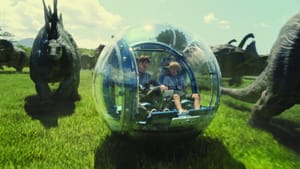Stay in the Loop
BSR publishes on a weekly schedule, with an email newsletter every Wednesday and Thursday morning. There’s no paywall, and subscribing is always free.
Nostalgiasaurus rex
'Jurassic World'

Jurassic World may remind you of a lot of things, and not just because the filmmakers have ladled on so much original Jurassic Park nostalgia that you wonder if they even made any new storyboards for this movie, over 20 years later.
Activist-minded viewers may get a flashback to Blackfish, the heartbreaking 2013 documentary about orcas in captivity (and the cetacean and human collateral of their theme park profit machines) when Chris Pratt, in the role of rugged velociraptor handler Owen Grady, trains a quartet of caged yet unnerving predators to follow his commands (yes, ’raptors have come a long way since the early ’90s).
Somebody’s already lost an arm to the ’raptor paddock before the movie opens; presumably OSHA isn’t operating on Isla Nublar.
Animals in the field
Previous Jurassic Park installments, once they broached the sheer majesty of a modern CGI dinosaur, touched on the conflicts between corporate interest and what the script of this film calls “assets” (as in, “the asset is out of containment!”). Jurassic World tries to dig into the U.S. military-industrial complex as well. Something about ’raptors wearing Bluetooths. (Really.) They want to work for the U.S. military about as much as Robert Downey Jr.’s Iron Man does.
In that vein, Grady has a warning: “They’re wild animals. You don’t want them in the field,” he growls at the idea that velociraptors could one day run outside their cage. That reminds me of the day last winter when a pair of llamas escaped their day jobs and ran amok through the roads, fields, and parking lots of Sun City, Arizona while a breathless nation watched full coverage from news copters.
Those llamas weren’t going to disembowel anybody, but they did demonstrate our rather bizarre terror of pretty much any animal besides ourselves roaming where it pleases: Foxes under Jersey shore boardwalks make headlines; sharks don’t glide by, they “close down beaches”; and even a free-range dog or wayward hen is apt to spark lawsuits in some neighborhoods.
Animals? Keeping them penned and leashed is the only way to go.
Unless you’re making a Jurassic Park movie. Because none of the fun can start until something gets out.
They do move in herds
Those who marveled at Jurassic Park in the ’90s will find plenty of fun, but there’s no getting around a few fundamental letdowns. In the original film, John Williams’s iconic score swells as Alan Grant and Ellie Sattler witness their first dinosaurs. (“They’re moving in herds. They do move in herds!”) Here, composer Michael Giacchino appropriates the majestic tunes as our young protagonists witness. . .a theme park vista. I remember a making-of featurette for The Lost World: Jurassic Park noting the special addition of stegosauruses to the action in response to viewer disappointment. In Jurassic World, they’re just CGI set dressing as theme park guests train, drive, kayak, and gyrosphere their way around the island, blissfully forgetful of the tragedies wrought there by the hubris of InGen and John Hammond.
And let’s face it: The struggle between ecological ethics and corporate greed, chaos and engineering, just can’t grab ya like a Spielbergian T-Rex rampant in a thunderstorm.
Until, due to the magic of “de-extinction” and, you know, “gene-splicing,” a dino-cum-frog-cum-cuttlefish dubbed the Indominus rex gets a wild hair for life outside the paddock. (Somehow, as park baron Claire, Bryce Dallas Howard’s blindingly pristine nude pumps survive every dash through the jungle.)
Forget GMO corn. This thing is badass: “She will kill anything that moves!”
Time with the kids
As the latest Jurassic Park mayhem unfolds, the most notable feature of the franchise may be how much its computer-generated reptile stars evolve as characters, versus its stock of human protagonists.
As I left the theater last weekend, I noticed a family with kids, all under 12, leaving the same showing. And it struck me how every Jurassic Park film is a traditional family drama at heart. Each one unfolds partially through the eyes of youngsters who are soon running for their lives, all of them delivered into danger as a result of their disintegrating families, and all coming under the fierce protection of people who never dreamed of spending any time with children. Families are formed or mended as parents and rescuers bond over the bedraggled little survivors. In the latest film, Claire’s repressed biological clock ticks louder than all the ’raptors’ feral gurgles, while Grady saves the day in a leather vest despite Claire’s brutal braining of a wayward pterodactyl.
Monsters are relative
No, you’ll have to look to the dinosaurs for the evolution of any unique (and non-traditionally-gendered) character dynamics in the Jurassic Park franchise. After all, the villainous Indominus rex is herself a lady.
“Monster is a relative term,” we learn in Jurassic World, in relation to the food chain: A cat might as well be a T-Rex to a mouse. (I admit I’ve often thought along those lines when I’ve watched spring robins cocking their heads for worms in the grass.)
But it’s also relative in how we view the dinos throughout the franchise. The awe-inspiring or terrifying monsters of 1993 (I think Jurassic Park is just about the greatest monster movie ever made because I was 10 when it came out) are, over the course of the four films, transformed by screenwriters into confidantes, allies, defenders, and even old friends.
In the end, T-Rex doesn’t lose its monster status because of our blasé 21st-century attitude to computer-generated beasts; it becomes a bona fide character through our own nostalgia for its original film incarnation and its evolving role in the action.
If you’re on the concrete, electrified, shoulda-built-it-higher fence about seeing Jurassic World this summer, quit being a snob. The theater I sat in was full of oohs and gasps. I’ve spoken to at least three discerning people who have already seen it twice. Get your two-hour dinosaur fix, whatever it reminds you of.
What, When, Where
Jurassic World. Story by Rick Jaffa and Amanda Silver, based on characters created by Michael Crichton; screenplay by Rick Jaffa, Amanda Silver, Colin Trevorrow, and Derek Connolly. Colin Trevorrow directed. Philadelphia area showtimes.
Sign up for our newsletter
All of the week's new articles, all in one place. Sign up for the free weekly BSR newsletters, and don't miss a conversation.

 Alaina Johns
Alaina Johns